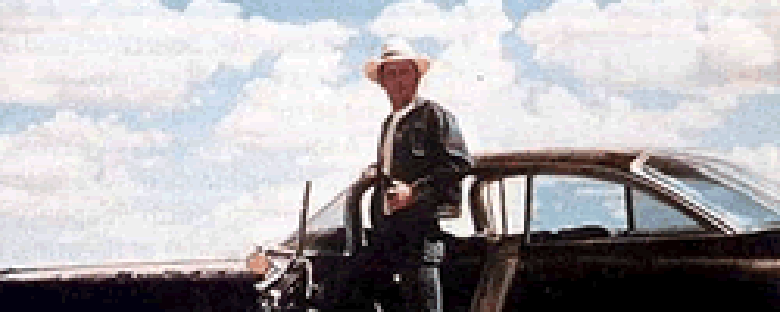Reviews
Terrence Malick
USA, 1973
Credits
Review by Rumsey Taylor
Posted on 10 July 2004
Source Warner Brothers DVD
Holly and Kit, the murderous couple of Terrence Malick’s Badlands, run fiercely from the scene of another of Kit’s shootings. Kit reaches out for Holly. It would be a climactic and romanticized scene of violence had Holly decided to join Kit’s hand. The two proceed accordingly, distinctly separate, with another unplanned escape.
This detail is important as it breaches Badlands’ inevitable resemblance to Bonnie and Clyde, a revolutionary film it followed by six years (its director Arthur Penn is thanked in the final credits). Both films involve a young, idealistic couple and the ensuing violence of their collaboration. Such a similarity is damaging to Badlands, as it fosters an expectation of violence, romance, and their integration. However, these traits that distinguish Bonnie and Clyde are deliberately underwhelmed in Malick’s film.
Static compositions summarize a South Dakota town. It is an anonymous and nondescript locale. Kit is a garbage man, Holly an unpopular and impressionable teen. He meets her, one day, on his walk home after work. The pair is compatible for their mutual need and shared fear of loneliness, similarities that found a superficial romance. He wants an audience, a girl to scream his name when he dies. Holly wants to be attractive to someone. Each requires attention to validate his and her self-worth, and for each the union is temporarily beneficial.
Badlands is taken from the Starkweather-Fugate killing spree in 1958 (an inspiration that lent the film a harmless controversy). The presumed horror of this inspiration is omitted in the film. The killings and deaths are generally devoid of any sympathy, reason, or apparent regret. The death of Holly’s father, the first murder, does not spur an expected response to the emotional trauma in either party. Holly does not even shed tears. The murder is treated as an awkward misstep, and is not explicit, nor is any killing in the film. Kit’s murders (Holly is affiliated with them only as a quiet witness) are sporadic and unanticipated; again, murder in this film is not an act of horror but of frustrated indifference. It is merely something to do.
The murder of Holly’s father triggers the couple’s exodus, and they travel across the American badlands, from the Dakotas towards Montana. The photography and colloquial dialect compliment the unmistakably American landscape — these punctuations contrast each other, as the visual emphasis distracts the banality of the speech, specifically Holly’s frequent voice-overs, stated in stark simplicity and without enthusiasm. The photography, secondly, implies that the interstate trip is a sort of reward for the couple’s emigration, though, importantly, they leave South Dakota and find nothing but an expanse of land in which telephone lines become indiscernible in inaccessible horizons (roads are sparsely included in the picture). This emptiness — this space — is both austere and exotic; entirely nonspecific and a welcome contrast to the opening’s suburban generalization.
Kit and Holly’s immediate hideout is a riverbank tree house, elaborated with several traps and organic weaponry. It is a romanticization of the sort of notoriety afforded, legitimately, by the title characters in Bonnie and Clyde, yet their resistance is largely imagined (there is speak of a state-hired task force to hunt them, and no proof). It is ridiculous and useless because there is no enemy to challenge its utility. The pair’s failure to truly liberate themselves from their ordinary heritages becomes apparent, as they domesticate: Holly applies makeup to her face, in spite of her seclusion. Kit becomes frustrated at his lack of success in catching a fish with a hand-woven net, cocks a pistol, and fires it into a quiet lake. The scene depicts a blemished Eden with undeserving representatives of each sex. The main couple is increasingly disinterested in each other and find themselves unable to refuse the banal amenities that coaxed their getaway.
Kit and Holly proceed to live against commonplace aspiration and the generic regularity of their previous existences. Neither these characters nor their outcomes are archetypically valuable. Malick has been criticized for condescension (justifiably, as the dialect of the film is cohesively unremarkable and generic). He is suggesting that banality fosters superficial desires and affords shallow rewards. The film is an arena for apathy, both in regard to the characters’ depictions and their subjective emotions. And at no point does either appropriately qualify the gravity of the crimes. Kit fires his gun with little predetermination, and Holly engages in naïve conversations with hostages that ignore the circumstance of their meeting.
Expectedly, Kit’s final capture is welcome, a desired epilogue and happy ending (despite the fact that Kit’s death sentence is implied). After successfully losing policemen in a rural car chase, he fixes his hair in the rear-view-mirror, shoots out his own tire and waits patient and eager for his arrest. In the final sequence Kit and Holly are temporarily held at an airport before their custodial flight back to South Dakota. Kit, with an audience of policemen, appraises his capture and answers questions like an interviewed celebrity. Kit has succeeded, as his arrest is the only action that will ensure any form of fame. In jest, he admits some of his favorite singers, and passes out a lighter, comb, and pen; perceived tokens of value as they bear his former possession. In their return, Holly studies Kit and smiles. For the first time, he, dressed in denim and a white T-shirt, matches her idealistic evaluation of attraction, and he has attained success. The final shot provides the exotic culmination of the film’s visual journey, as it approaches a sunset in between horizontal layers of clouds.
We don’t do comments anymore, but you may contact us here or find us on Twitter or Facebook.



